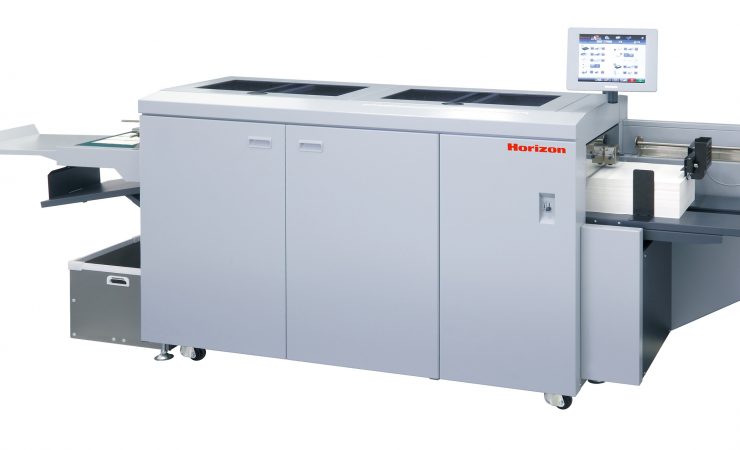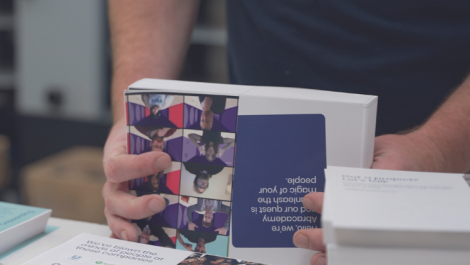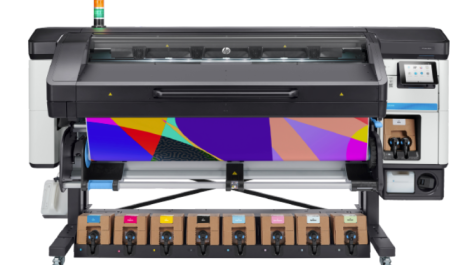Producing lots of small jobs efficiently is one of the main attractions of digital print, but it only works when the finishing line can keep up. Simon Eccles cuts through the fog
Fast press response in short-run printing is all very well but not much good if the job then has to go through five finishing stages on five separate machines that each have to be set up, loaded and unloaded. Fast printing needs to be followed by fast finishing, preferably with automated set-up and combining functions where possible.
Some printers opt for inline finishing units, generally booklet makers that can fold and stitch, but sometimes perfect binders. Their great benefit is they can be set up from the same controls as the press and don’t need extra operators. On the other hand if something breaks then both printing and finishing stops until it’s fixed. You need one line per printer, with the notable exception of CP Bourg’s BSF system that lets an inline system on one printer accept stacks from other printers.
Multi-finishers
Broadly speaking, finishing machines are faster than digital presses, so it makes a lot of sense to have separate nearline finishing that can serve two or more presses without breaking a sweat.
That’s why multi-finishers were invented, to do a sequence of tasks in one compact box, normally combining slitting and cross-cutting, scoring and perforating. That’s enough for common jobs such as business and greetings cards, brochure covers and simple slitting and cutting that can be more operator-efficient than a guillotine for small quantities. It’s useful to have a barcode reader and an offsetting stacker to separate sets in the delivery.
Duplo invented the multi-finisher as we know it with its DC-645 in the mid-2000s. Today it offers three main models, each with a few configuration options. The range starts with the £18,000 DC-616 Pro, aimed at copyshops, small print works and similar. It can slit, cut, crease and perforate at up to 10 sheets per minute, depending on the precise functions used, with unattended running. Computer control includes job memories, with a camera to read barcodes and detect marks to compensate for print drifting on the sheet. Its maximum sheet size of 333 x 999mm is compatible with a lot of today’s ‘long-sheet’ SRA3 digital presses.
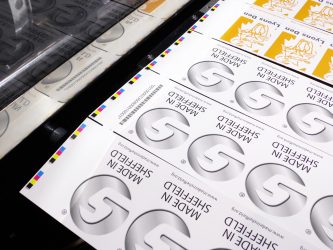
Rollem builds to order so you can have pretty much whatever you want
The mid-range model is the £35,000 DC-646i, which replaces the original DC-645. It is intended to serve busy print shops with multiple digital presses, finishing up to 30 sheets per minute. The Pro package bundles together the most popular modules and options and the IFS (Integrated Finishing System) option adds extra folding functions.
A £3000 DC-646i JDF option is offered to use with HP Indigo digital presses. It communicates with the HP SmartStream front end, which can write job tickets for the DC-645i. Other presses can swap data with the DC-646i by using Ultimate Technographics’ Ultimate Finishing workflow software. Ultimate Finishing will also drive finishers from CP Bourg, Horizon, Perfecta, Plockmatic, Tecnau, Watkiss (now part of Plockmatic) and others.
The top Duplo multi-finisher is the £55,000 DC-746. This runs nearly twice as fast as the DC-646i, at up to 50 sheets per minute. It’s aimed at printers with high speed presses and also has a JDF option.
Morgana is the distributor for Japanese Uchida multi-finishers in the UK and Scandinavia. Its AeroCut Prime is roughly equivalent to the Duplo DC-646i in capabilities. Its speed depends on setup, such as nine 21-up business cards per minute, or 21 trimmed A3 leaflets with a centre crease; an optional unit can cut 25 cards from a sheet. It takes sheets up to 370 x 900mm and 400gsm and offers slitting, cross-cutting, creasing, cross-perforation and micro perforation. PDF design templates are available to give to artwork creators. A Morgana Autofold folding unit can be added inline.
Horizon’s SmartSlitter competes on features, speed (at 54 sheets per minute) and price with the top Duplo DC-746. Its maximum sheet format is smaller though, at 370 x 670mm. Apart from slitting it can also gutter cut, edge trim, cross-cut, perforate and crease in the same pass. An optional cassette adds skip perforation. A barcode reader automatically adjusts for print position. There’s a choice of a 90mm high stacker or a conveyor delivery.
For B2 work, the SmartStacker can run inline with HP Indigo 10000/12000 presses and converts sheets into up to 28 separate items (seven widthways and four lengthways), with full bleed edge and gutter trimming. It can also run nearline at 4500 B2 sheets per hour.
Both the SmartSlitter and the SmartStacker have optional links to Horizon’s pXnet finishing room network and wider JDF networks, if required. SmartStacker can also link to HP’s Direct2Finish and SmartStream Production Pro DFE.
Pretty well anything the UK finishing manufacturer Rollem sells is custom-configured for individual customers, to the point that it stopped using traditional model names and numbers a couple of years ago. It offers sets of finishing modules that can be linked to handle pretty well any finishing sequence you need, to run nearline or inline with digital presses. You could opt to build something that would count as a multi-finisher, though not in the compact one-box format supplied by Duplo, Horizon and Morgana/ Uchida. There’s a choice of modules to bleed slit, trim, micro-perforate, number, perforate, score, slit-perforate, die-cut or punch, collate and wrap (for playing cards) or stack, with a barcode reader.
Rollem can support up to B1 sheets for some functions, and has worked with Konica Minolta to build a bridge unit for the B2 AccurioJet KM-1 inkjet press that can send printed sheets to either inline or nearline finishing units.
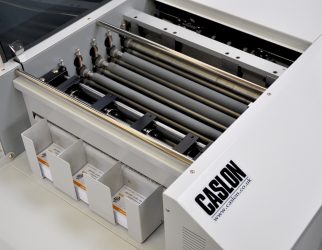
The Caslon Zip21A can deliver 228 business cards a minute
Vivid’s VeloBlade new flatbed cutter isn’t billed as a multifinisher but it covers some of the same territory, offering x-y full or kiss cutting and perforating plus creasing of sheets up to 400 x 600mm and up to 1500micron thickness, which includes various packaging materials. Cutting templates can be created in Adobe Illustrator and the various paths assigned as cut or crease guides, with perforation in any direction possible via dashed lines. It requires manual set-up to register the sheet, so isn’t aimed at volume production – cutting/creasing each sheet takes up to 45 seconds depending on number and complexity of cuts – but offers flexibility for more creative
applications or prototyping that might otherwise require diecutting.
Add-on wheels
If you’ve got a folder or a suitable saddle stitcher or even some types of press, a low cost alternative to some of the functions of a multi-finisher is to fit cutting, creasing or perfing wheels to a suitable shaft or swing arm. Many folder makers can offer these as standard to take steel slitting wheels on the exit path of the first folding unit.
In 2000 UK based Tech-ni-Fold came up with a clever alternative system of oval rubber rings for shaft-based add-on creasing wheels, to fit on folders and the like. It added microperfing and cutting wheels and called the system Tri- Creaser. It can now offer some 500 variations.
Tech-ni-Fold can also supply its system ready-built into small standalone machines, through its CreaseStream business. The £1897 CreaseStream Mini base model is hand-fed a sheet at a time and operated manually with a rotary handle. It has potential for up to 1000 sheets per hour – if you can feed it fast enough. The £2997 Mini Quick-Feed allows several sheets to be loaded at once, so 3000sph is achievable. The £4697 Mini Auto-Feed has a motor and automatic stack feeder for up to 4000sph. All models will handle sheets from 65 to 350gsm, in widths from 80 to 520mm.
Card cutters
Card cutters can be productive alternatives to guillotining. You can find cheap ones online, but if you need to make a living from them you’ll need something more robust. Rollem makes card cutters to handle sheets from SRA3 to B1, needing only a 1.6mm separation between bleed cards on a sheet compared to 6mm for a guillotine – that’s enough to get an extra row on some formats.
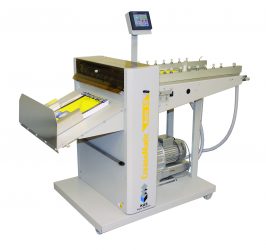
KAS CreaseMatic CM Auto50 – one of the company’s matrix creasers available through Ashgate
Caslon’s card cutters are resold though several finishing specialists, including Encore Machinery. Its £7250 desktop SRA3 format Zip-21 cuts 228 cards a minute via 21-
up layout on up to 350gsm stock, with 4-edge bleed if needed. The perforating and scoring cassettes let you make tickets and foldover products. The entry-level A4 Zip-10m costs £3750. Faster models from £14,465 to £39,285 progressively offer suction feed, weights up to 500gsm, perfing, creasing and hole punching. The top-of-therange Zip-CS2L costs £80,195, with two tool stations for embossing and round-cornering.
Caslon also sells the Therm-O-Type RAS (right angle slitter), with two inline drop-in cassette wheel units running at up to 6000sph, with optional auto-adjustment. It offers similar speed and accuracy to multi-finishers for about the same price, at £67,210.
Duplo’s DC-515 is a 6000sph production card cutter with a lot in common with the company’s multi-finishers, with swappable pre-set cassettes, but only runs one function at a time. It costs from £25,000.
Creasers
Encore Machinery is a long-standing supplier of the PitStop range of standalone creasers made by Bacciottini In Italy. They use cross blades with rubber matrix formats. There’s a remarkably large choice, starting with the Pitstop 36 creaser-perforator with touch screen setup, for sheets up to 360 x 700mm (or 360 x 850mm with extension), running at 7500 A4 single-crease sheets per hour. There are faster models, and some can run inline with a folder. The most versatile is the PitStop/MB Digital inline creasing and folding system, which can produce finished mailers, with provision for tip-on gluing, perforating, creasing, trimming, turning, buckle folding, plough folding, with optional ink jetting and camera reading.
Terry Cooper Services supplies the Italian Endevor Matrix standalone creasers, which can also have perforation tools fitted. Two 500mm wide models offer 3500 or 6000 A4 sheets per hour with a single crease.
KAS Paper Systems makes the CreaseMatic range of matrix creasers in Dunstable, with Ashgate as its long-standing agent. The base model 150P is hand-fed for up to 2000sph and can be run with the inline CreaseFold unit for single knife folding. The Auto 50 Touch has suction feed and programmable memory and handles SRA2 sheets (500 x 700mm) at over 8000sph.
Although most printers will still feel the need for a conventional guillotine and folder, these card cutters, creasers and more complex multi-finishers can handle a lot of digital finishing jobs more efficiently with less handling. They are worth exploring.
